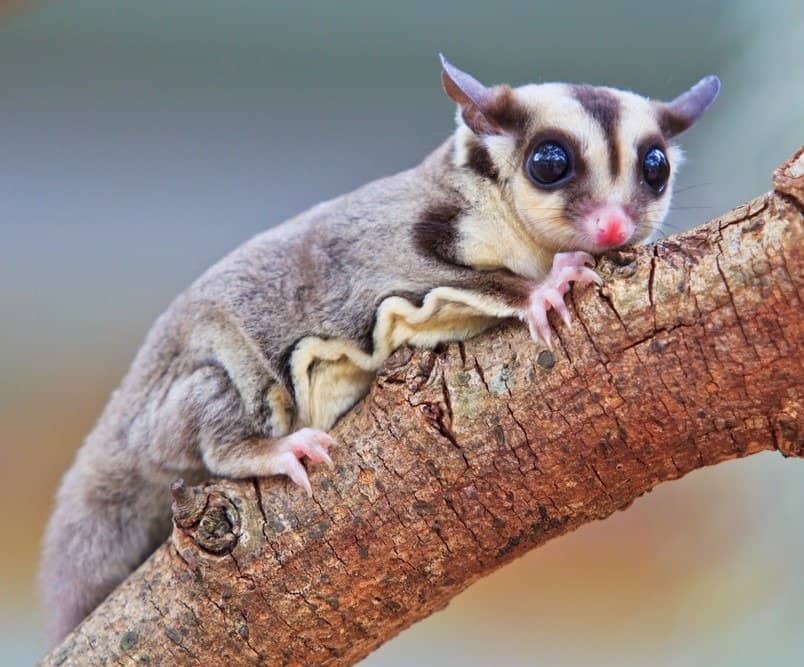
Sugar gliders are big-eyed marsupials that are relatives of the kangaroo.
©apiguide/Shutterstock.com
Sugar gliders are marsupials that come from Australia. Big eyes, bushy tails, and short, round bodies are the common physical characteristics of these nocturnal creatures. Their tails are the same length as their bodies.
Typically, the largest species weigh less than five ounces (80 to 160 grams). It is easy to fall in love with them, and they can be kept as pets, but you should know everything you can about them before you bring one home.
1. Their Dietary Needs Are Expensive

Diet is a crucial concern for any pet that you get. With exotic pets like the sugar glider, you must understand their diet to prevent health issues, depression, and premature death. The average lifespan of these marsupials is 10 to 12 years if they have the proper diet, nutrition, and exercise.
The containers they eat out of should be hung high on the sides of the cage. Placing food on the bottom of the cage will cause the food to be ignored. A diet combining insects, worms, fruits, and commercial pellets will give the glider ample nutrition.
What to Feed Sugar Gliders
| Commercial Pellets | 1 tsp. daily |
| Fruits, vegetables, and nuts | 2–3 tsp. daily |
| Insects and worms | occasionally as treats |
2. Sugar Glider Health Concerns
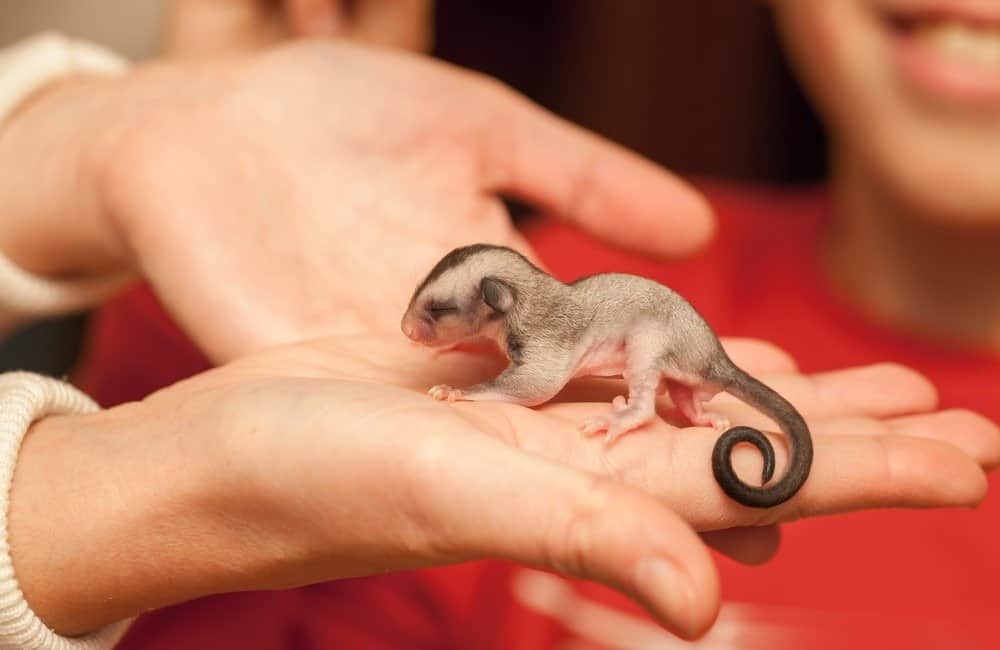
The second reason is that they need specialized veterinarians to manage their health concerns.
©Evannovostro/Shutterstock.com
Not all veterinarians in the United States have the appropriate training to treat these exotic animals. Health conditions like kidney stones caused by eating foods such as kale or spinach, which are calcium-rich and contain high oxalates, might go undiagnosed if the veterinarian seeing the animals does not know what they are looking for.
Common Diseases Affecting Sugar-Gliders in Captivity
| obesity |
| diabetes mellitus |
| metabolic bone disease |
| hyperparathyroidism |
| pneumonia |
| iron storage disease |
| nutritionally based diarrhea |
| tetany |
| teeth/gum problems |
| gastrointestinal problems |
| cancer |
| internal parasites |
3. Sugar Gliders Need Large Habitats
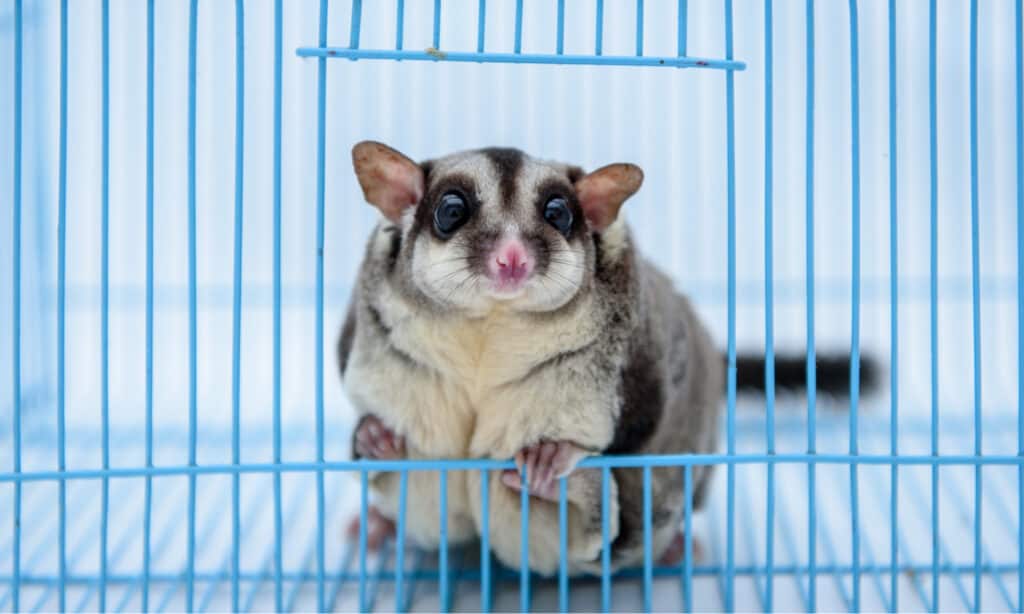
The third reason to avoid getting a sugar glider is they need a large habitat.
©MARVIK/Shutterstock.com
For an animal so small, a sugar glider requires a lot of room to move around. The habitat needs to be 20″ x 20″ x 30″ for just one of the tiny creatures. The habitat must be a cage of wire or metal bars spaced closely enough that the glider cannot squeeze through them. If they can escape the cage, they will, and often they cannot be found after they escape.
Temperatures suitable for these marsupials range between 59 and 86 degrees Fahrenheit (15 and 30 degrees Celsius). Their area should have enough light to discern night from day, but their cage must not be placed in the path of direct sunlight.
Habitats for nocturnal creatures must not be in busy areas during the day so the little gliders can get the sleep they need. A nesting area is required in the cage, and you should line the bottom of the cage with shavings or loose bedding.
4. Sugar Gliders are Vocal
Tiny but loud is a good description for a sugar glider. Barking is a familiar sound you will hear these little guys making. They also chatter, chirp, hiss, and even scream or screech when afraid, injured, or irritated.
The Noises Sugar Gliders Make and What They Mean
- Barking is a way to warn other gliders of danger, and it is used to call other gliders or their owner when they want food, attention, water, are out of their cage, or need help.
- Hissing indicates that they are frightened. Angry or otherwise upset. Hissing is often heard when two gliders are playing with each other.
- Hissing sneezes are made when they are grooming themselves.
- Chirping and chattering are noises they make when they are happy.
- Crying sounds that sound like a whimper are made when they are sick or in pain.
5. Sugar Gliders are Nocturnal
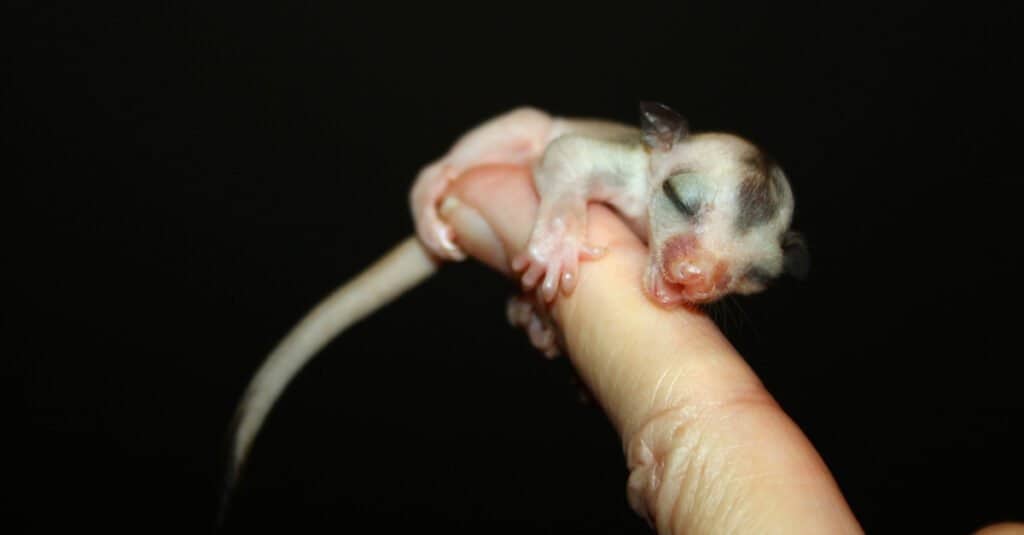
The fifth reason is because they are nocturnal and asleep when you are awake.
©Doty911/Shutterstock.com
Nocturnal creatures like bats and sugar gliders sleep during the day and are awake at night. If you work during the day and sleep during the night, having a glider in your home will disrupt your sleep patterns. Also, your daytime activity will disturb the sugar gliders’ sleep pattern. If neither you nor the glider gets the proper sleep, you will become grumpy and hard to get along with.
6. Sugar Gliders Require Regular Socialization
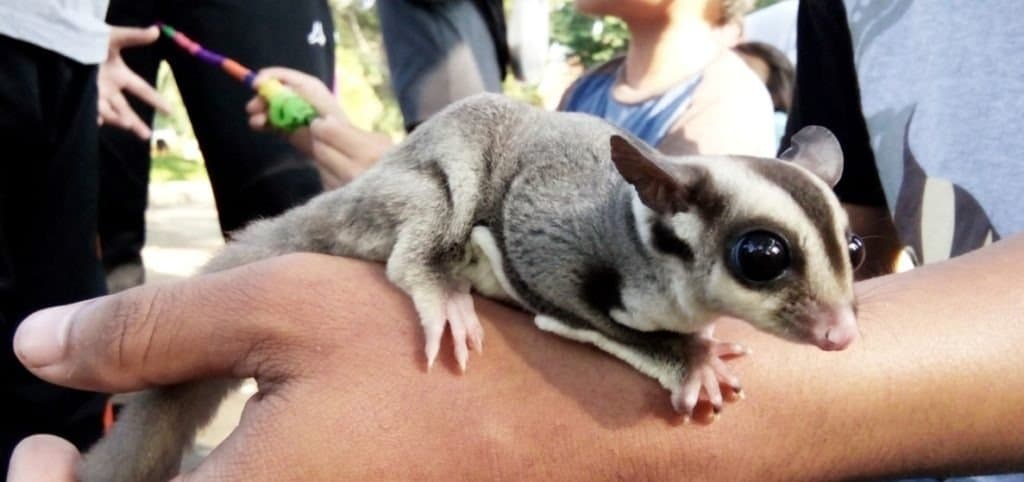
The sixth reason is that they need extra attention and socialization to be comfortable with you.
©rizka ku/Shutterstock.com
Attention from you will be regularly required to tame the glider and maintain a bond with them. If you do not touch, pet, and hold them daily, they can become depressed or standoffish to you. If you bring a sugar glider home as a pet, you must be committed to spending time with it daily.
Daily handling should be done at night when the marsupial is awake and alert. You can snuggle the glider while it sleeps during the daytime by holding its sleeping pouch.
7. Sugar Gliders Require Frequent Grooming

The seventh reason is that they have pungent odors and need regular baths.
©Kurit afshen/Shutterstock.com
Pungent and unpleasant odors are part of the sugar glider package. To reduce the foul odors, you can bathe and groom the animal regularly, ensure they are eating a perfectly balanced diet for their nutritional needs, and litter box train them to help keep the urine and feces odors to a minimum.
Deep cleaning of their habitats has to be done regularly because the odor will be strong when their cage is dirty. A dirty cage also leads to health problems for the sugar glider.
8. Sugar Gliders are Not Recommended for Children Under 6

The eighth reason to avoid getting sugar gliders is they are not recommended for children under 6.
©I Wayan Sumatika/Shutterstock.com
Children under the age of six will have to be constantly supervised when they are handling or around a sugar glider. The marsupials are so small that they can be injured easily if the child is too rough when they handle them. Gliders also become aggressive and can bite the child.
Gliders get along with other animals, but having sugar gliders with cats or dogs in a home can be risky. These exotic animals smell different than the dog or cat is accustomed to, and the other animals may attack the sugar glider.
9. You Need More Than One

The ninth reason is that one glider gets depressed and lonely, so you need more than one.
©I Wayan Sumatika/Shutterstock.com
Social creatures like sugar gliders do not do well when they live alone. These little gliders need a friend of their species to spend time with, converse with, and play with. Without the companionship of another glider, your pet will become distant and depressed, lose their appetite, and may become angry and aggressive.
10. Aggression Concerns
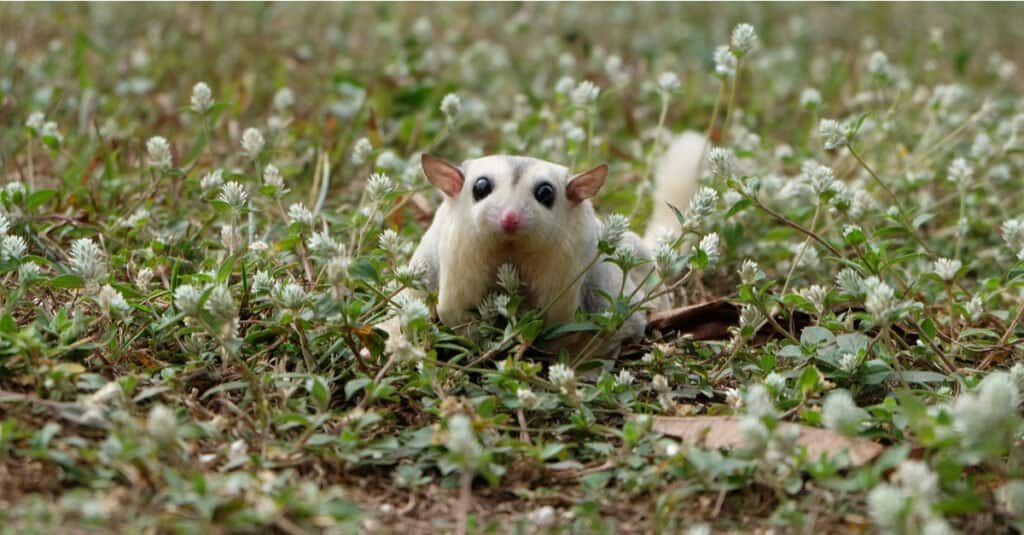
The tenth reason is because they can become aggressive, especially when you have more than one.
©i3iwtz/Shutterstock.com
Aggression is a concern, even though sugar gliders are small. You do not want them biting or scratching you or your family members. When you have more than two gliders, the creatures may start to bond with each other and not want you or other humans to interfere with them. When living in a group of three or more, the gliders often become aggressive towards humans and sometimes towards one of the other marsupials.
11. Can Be Hard to Tame
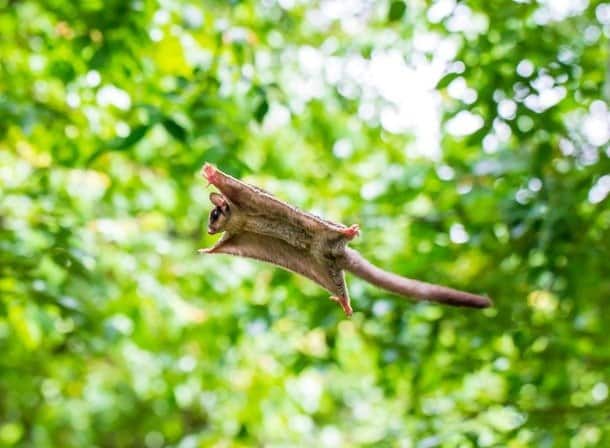
The eleventh reason is that taming them takes time and patience.
©Anom Harya/Shutterstock.com
Patience is a virtue when trying to tame or train a sugar glider. Repetitively doing the same thing without change will teach the glider what you expect of it. They do not learn new behaviors quickly, so be gentle, firm, and patiently show them what you want them to do until they begin to respond.
Positive reinforcement techniques, like rewarding them with a treat they like, are better suited to training gliders. Negative responses and discipline will only make the glider try to avoid or be aggressive toward you.
12. Not Legal In Every State

The twelfth reason is that owning a sugar glider is illegal in all states.
©LesPalenik/Shutterstock.com
Owning sugar gliders is illegal in Alaska, California, and Hawaii. In Pennsylvania, the marsupials may be kept as house pets, but breeding them for profit is forbidden. Some cities ban the ownership of sugar gliders even though their state has no regulations against them. If you live in New York City or St. Paul, Minnesota, you cannot own a sugar glider as a house pet.
Before you get a sugar glider, check your state and local regulations to ensure they are permitted where you live. If you rent your home or apartment, check with your landlord to see if you can keep a sugar glider there.
Summary of 12 Reasons to Avoid Getting a Sugar Glider as a Pet
| 1) Expensive Dietary Needs |
| 2) Health Concerns |
| 3) Require Large Habitats |
| 4) Vocal |
| 5) Nocturnal |
| 6) Require Regular Socialization |
| 7) Require Frequent Grooming |
| 8) Not Recommended for Children Under 6 |
| 9) Need Other Sugar Gliders as Companions |
| 10) Aggression Concerns |
| 11) Can Be Hard to Tame |
| 12) Not Legal In Every State |
Thank you for taking the time to read this article. To learn more about sugar gliders as pets, visit AZ-Animals.
Thank you for reading! Have some feedback for us? Contact the AZ Animals editorial team.







